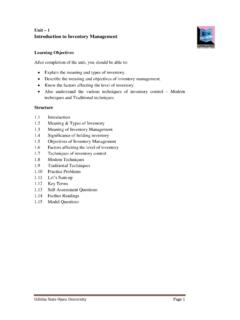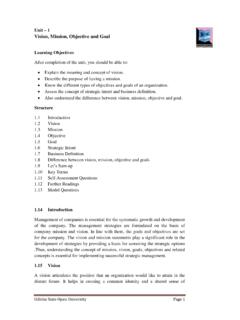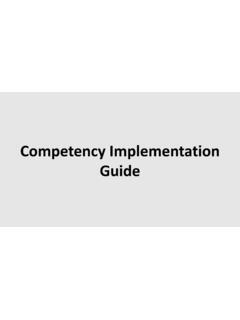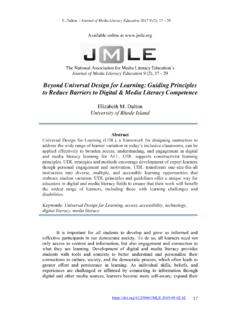Transcription of Unit-1 Strategic Management: An Overview - Odisha State …
1 Unit-1 . Strategic Management: An Overview Learning Objectives Strategic After completion of the unit, you should be able to: Management: An Overview Explain the concept and definition of strategy & Strategic management. Know the features/characteristics of Strategic management. Understand the importance of Strategic management. Explain the different levels of strategy. Describe the benefits of Strategic management Structure Introduction Concept and Definition of Strategy Features/Characteristics Need and Importance of Strategic Management Approaches to Strategy Levels of Strategy Benefits and Limitations of Strategic Management Let s Sum-up Key Terms Self-Assessment Questions Further Readings Model Questions Introduction Strategic Management is a relatively new discipline focused in the field of management, and provides overall direction to an organization for attaining its objectives and achieving success. It is an ongoing process in which an organization continuously updates its strategies with respect to changes taking place in the ever changing business environment.
2 The top management of an organization concerned with selection of a course of action from among different Odisha State Open University Page 1. alternatives to meet the organizational objectives. The process by which objectives are formulated and achieved is known as strategicmanagement and strategy acts as the means to achieve the objective. Strategy is the grand design or an overall 'plan' which an organization chooses in order to move or react towards the set objectives by using its resources. Strategies most often devote a general programme of action and an implied deployment of emphasis and resources to attain comprehensive objectives. An organization is considered efficient and Strategic operationally effective if it is characterized by coordination between objectives Management: An Overview and strategies. There has to be integration of the parts into a complete structure. Strategy helps the organization to meet its uncertain situations with due diligence.
3 Without a strategy, the organization is like a ship without rudder. It is like a tramp, which has no particular destination to go to. Without an appropriate strategy effectively implemented, the future is always dark and hence, more are the chances of business failure. Concept and Definition of Strategy Concept of Strategy The word strategy'has entered in the field of management from the military services where it refers to apply the forces against an enemy to win a war. Originally, the word strategy has been derived from Greek 'strategos' which means Generalship. The word was used for the first time in around 400 BC. The word strategy means the art of the general to fight in connotes the art and science of directing military forces. The strategy, according to a survey conducted in 1974 which asked corporate planners to define what they meant by strategy, includes the determination and evaluation of alternative paths to an already established mission or objective and eventually, choice of the alternative to be adopted.
4 Simply put, a strategy outlines how management plans to achieve its objectives. Strategy is the product of the Strategic management process. Generally, when we talk of organisational strategy, it refers to organisation s top level strategy. However, strategies exist at other levels also. Chandler made a comprehensive analysis of interrelationships among environment, strategy, and organisational structure. He analysed the history of organisational change in 70. manufacturing firms in the US. While doing so, Chandler defined strategy as: The determination of the basic long-term goals and objectives of an enterprise and the adoption of the courses of action and the allocation of resources necessary for carrying out these goals . Chandler refers to three aspects: l Determination of basic long-term goals and objectives. l adoption of courses of action to achieve Odisha State Open University Page 2. these objectives, and l allocation of resources necessary for adopting the courses of action.
5 The dictionary meaning of strategy is, "the art of so moving or disposing the instrument of warfare as to impose upon enemy, the place time and conditions for fighting by one self.". Strategic Strategic Management is all about identification and description of the strategies Management: that managers can carry so as to achieve better performance and a competitive An Overview advantage for their organization. An organization is said to have competitive advantage if its profitability is higher than the average profitability for all companies in its industry. Definitions In management, the concept of strategy is taken in broader terms. Igor Ansoff (Father of Strategic Management) viewed that in developing strategy, it was essential to systematically anticipate future environmental challenges to an organization, and draw up appropriate Strategic plans for responding to these challenges. Strategy is organisation s pattern of response to its environment over a period of time to achieve its goals and mission.
6 In 1960 s, Chandler defines strategy as the determination of basic long-term goals and objectives of an enterprise and the adoption of the course of action and the allocation of resources necessary for carrying out these goals . According to Glueck, "Strategy is the unified, comprehensive and integrated plan that relates the Strategic advantage of the firm to the challenges of the environment and is designed to ensure that basic objectives of the enterprise are achieved through proper implementation process.". The analysis of the above definition describes the following: Unified comprehensive and integrated plan. Strategic advantage related to challenges of environment. Proper implementation ensuring achievement of basic objectives. Michael porter defines strategy as creation of a unique and valued position involving a different activity from rivals or performs similar activities in different ways.. Odisha State Open University Page 3. Michael Porter defines strategy as creation of a unique and valued position involving a different activity from rivals or performs similar activities in different ways.
7 Features/Characteristics Strategic Strategic Management as a distinct field of study has the following features or Management: An Overview characteristics: a. Strategy is Significant because it is not possible to foresee the future without a perfect foresight; the firms must be ready to deal with the uncertain events which constitute the business environment. Therefore we can say that strategy is future oriented. b. Strategy deals with long term developments rather than routine operations, it deals with probability of innovations or new products, new methods of productions, or new markets to be developed in future. c. Strategy is created to take into account the probable behaviour of customers and competitors. Strategies dealing with employees will predict the employee behaviour. d. Strategy is a blend of internal and external factors of the organization (SWOT) analysis of the organization. e. Strategy provides overall framework for guiding organizational thinking and action.
8 Need and Importance of Strategy Planning or designing a strategy involves a great deal of risk and resource assessment, ways to counter the risks, and effective utilization of resources all while trying to achieve a significant purpose. An organization is generally established with a goal in mind, and this goal defines the purpose for its existence. All of the work carried out by the organization revolves around this particular goal, and it has to align its internal resources and external environment in a way that the goal is achieved in rational expected time. Odisha State Open University Page 4. Undoubtedly, since an organization is a big entity with probably a huge underlying investment, strategizing becomes a necessary factor for successful working internally, as well as to get feasible returns on the expended money. Strategic Management on a corporate level normally incorporates preparation for future opportunities, risks and market trends.
9 This makes way for the firms to analyze, examine and execute administration in a manner that is most likely to Strategic achieve the set aims. As such, strategizing or planning must be covered as the Management: deciding administration factor. An Overview Strategic Management and the role it plays in the accomplishments of firms has been a subject of thorough research and study for an extensive period of time now. Strategic Management in an organization ensures that goals are set, primary issues are outlined, time and resources are pivoted, functioning is consolidated, internal environment is set towards achieving the objectives, consequences and results are concurred upon, and the organization remains flexible towards any external changes. As more and more organizations have started to realize that Strategic planning is the fundamental aspect in successfully assisting them through any sudden contingencies, either internally or externally, they have started to absorb strategy management starting from the most basic administration levels.
10 In actuality, strategy management is the essence of an absolute administration plan. For large organizations, with a complex organizational structure and extreme regimentation, strategizing is embedded at every tier. Apart from faster and effective decision making, pursuing opportunities and directing work, Strategic management assists with cutting back costs, employee motivation and gratification, counteracting threats or better, converting these threats into opportunities, predicting probable market trends, and improving overall performance. Keeping in mind the long-term benefits to organizations, Strategic planning drives them to focus on the internal environment, through encouraging and setting challenges for employees, helping them achieve personal as well as organizational objectives. At the same time, it is also ensured that external challenges are taken care of, adverse situations are tackled and threats are analyzed to turn them into probable opportunities.















